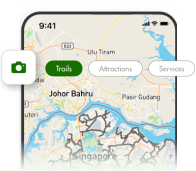
Government agencies communicate via .gov.sg websites (e.g. go.gov.sg/open). Trusted websites

Look for a lock (
Mission and history
Our mission
To create the best living environment through excellence in nature conservation, greenery and recreation, and veterinary care, in partnership with the community
Our values


Our goals
- To provide and manage stimulating, diverse and valuable greenery
- To inspire ownership and care for our greenery and nature
- To promote 'green' recreation as a lifestyle
- To manage nature areas for the advancement of life sciences
- To achieve organisational excellence
Our organisation
Refer to the following to find out how our organisation is structured.
Our History
Singapore's greening journey began in the 1960s.
We build on what Singapore has achieved as a biophilic City in a Garden and further integrate nature into our city to strengthen Singapore’s distinctiveness as a highly liveable city.
We aim to reduce the impacts of urbanisation and climate change so that Singaporeans can enjoy cleaner air and water, cooler urban temperatures, and benefits to health and well-being.
Planting the first trees
The history of NParks is closely interlinked with the history of tree planting in Singapore. When the Singapore government embarked on nation-building, Founding Prime Minister Mr Lee Kuan Yew envisioned Singapore as a Garden City.
He wanted to create a city-state within a garden environment consisting of parks, gardens and open spaces linked by a matrix of tree-lined roads and park connectors for cyclists and pedestrians. He believed that a well-tended Garden City would benefit its inhabitants and serve as a key competitive factor to attract foreign investors to the country.
First nationwide Tree Planting Campaign
Founding Prime Minister Lee Kuan Yew launched our first nationwide tree-planting campaign, signifying the start of the greening movement in Singapore.
Setting up of the specialist Parks and Trees Unit
The Public Works Department (PWD) set up the specialist Parks and Trees Unit.
Formation of the Garden City Action Committee (GCAC)
The Garden City Action Committee (GCAC) was formed to oversee policies for greening the whole island and coordinate the activities of the various government agencies in this respect.
Launching of the Annual Tree Planting Day
The Annual Tree Planting Day was launched and became a fixture on our nation’s calendar in the first week of November.
Setting up the Parks and Recreation Department
The Singapore Botanic Gardens was the lead organisation providing the expertise and plant materials for the greening programmes.
In 1973, it merged with the Parks & Trees Unit, which became the Parks and Recreation Department (PRD) under the Ministry of National Development in 1975.
The Parks and Trees Act and greening up the island
The Parks and Trees Act was passed alongside a directive from then Prime Minister Lee Kuan Yew to green up the island with as many trees as possible in the shortest time to provide shade and soften the concrete landscape.
The Act set out the guidelines for promoting and maintaining greenery in Singapore inclusive of the conservation of trees in designated Tree Conservation Areas.
It made landscaping mandatory for all new developments, requiring them to dedicate space for planting trees along roads, in car parks, and within housing estates. This standard was also adopted by other agencies like Jurong Town Corporation and the Housing Development Board in their development plans.
Early planting focused on fast-growing shade trees like Angsana and Rain Trees. Later phases introduced flowering (such as Yellow Flame and Red Flame) and fragrant trees (such as Tembusu and Gardenia). Road codes ensured space for planting trees along new roads. Beyond shade, fruit trees, flowering shrubs (such as Bougainvillea and Cassia) and creepers added colour. Parks became "green lungs" in the city, and residential property developers were also required to plant roadside trees and set aside land for open space.
The greening initiative continued into the 1980s focusing on refinement and efficient management.
Establishment of the National Parks Board
The National Parks Board (NParks) was established as a statutory board under the Ministry of National Development to manage and enhance the national parks, comprising Singapore Botanic Gardens and Fort Canning Park, and the nature reserves.
Merger of NParks and Parks and Recreation Department
NParks was expanded to incorporate the roles of the Parks and Recreation Department. NParks continued to spearhead the maintenance of the garden city and its roadside greenery, as well as develop new parks while upgrading existing ones.
It also developed a comprehensive network of park connectors to bring the island’s parks and green spaces to the community.
Creating a Biophilic City in a Garden
NParks’ mission evolved from creating a Garden City to a City in a Garden, seeking pubic input through a public engagement exercise to shape this vision. 6 key areas were identified, with open invitations for feedback and collaboration.
Formation of Animal & Veterinary Service (AVS)
Animal health and welfare, and animal management functions from the former Agri-Food and Veterinary Authority of Singapore (AVA) were transferred to the newly-formed Animal & Veterinary Service (AVS) as a cluster of NParks.
Combining animal health, welfare, and management under AVS strengthened NParks' position as a one-stop service to communities and stakeholders with regard to human-animal interactions, disease detection and response, and overall animal well-being.
AVS also serves as the main touchpoint on animal- and veterinary-related issues for pet owners, businesses and animal welfare groups. As the first responder for animal-related feedback, it also has an important role in upholding high standards in animal welfare and health.

_resized.jpg)




